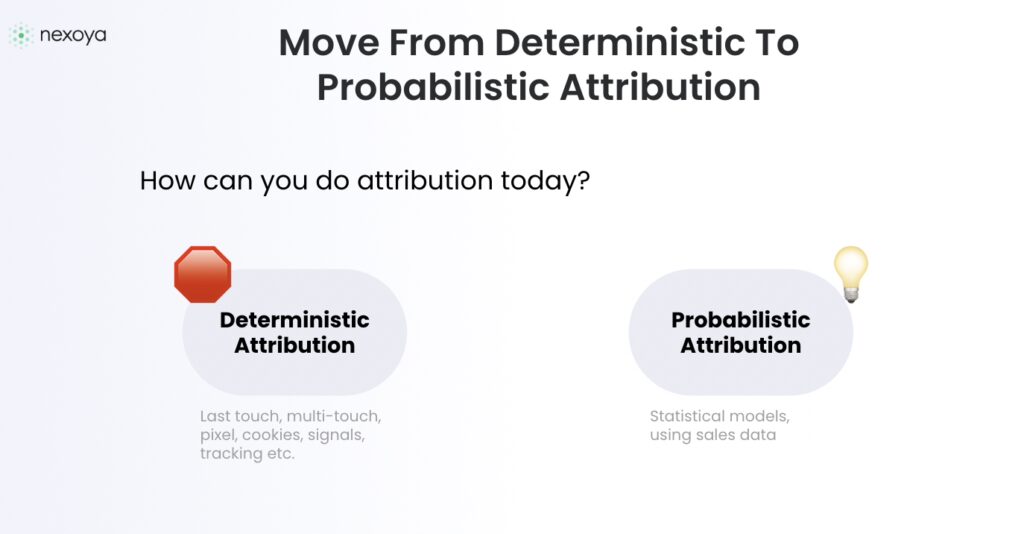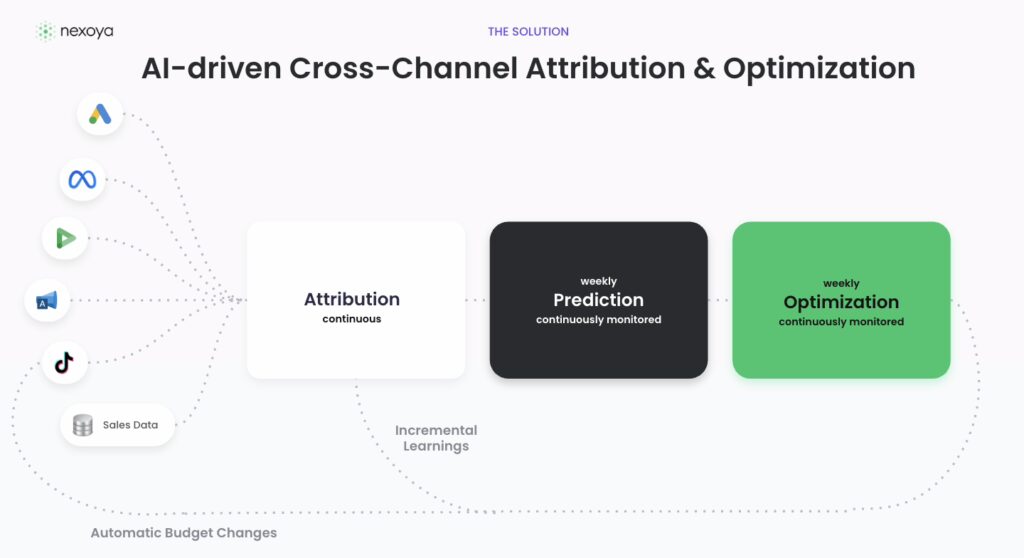The Attribution Dilemma
Every digital marketer knows the challenge of digital attribution today. It’s increasingly difficult to measure and attribute conversions/orders and sales across digital channels, campaign tactics and ad sets.
For a long time, we’ve been optimizing based on multi-touch attribution, last touch attribution, bathtub attribution, or what I call a deterministic approach. You try to gather as many signals as possible from a customer and model its customer journey to attribute as accurately and deterministically as possible. It’s an excellent method, but in the world of cookie deprecation, technical limitations, consent modes and data privacy restrictions, this gets harder. On the other side, the view-through component (so if someone sees your ad, doesn’t click, but still gets stimulated by it) is disregarded completely most of the time. Many historical methods of MTA have been based on signals (i.e. Hidden Markov Model, DDA in Google Analytics and so forth). So it’s not working and won’t work anymore, we’ve an attribution dilemma.
Obviously, there are also the publisher’s pixels that Meta, Google, TikTok, etc. would like you to use, but at the end of the day, they have a siloed view of the problem, ignoring the cross-channel effects and potentially over-attributing their own effect. It’s clear that the conversions need to be cleaned and unified before making decisions based on the data generated by analytics or pixels, but how? Also, the method of triangulation, which I talked about in the last post, didn’t really work or is too cumbersome to implement.
From Deterministic to Probabilistic Models
On the other hand, one can look into the probabilistic way of solving this problem. When there is enough data in a fully anonymized/normalized format (i.e. impressions, sessions, conversions) then statistics can help us to determine the effect of each channel. Tons of providers try this, it’s called “Marketing mix model”, where you take 18-24 months of data and use sophisticated regression models to attribute a conversion of each channel. Upfront, this is an excellent method to help you find out what happened in the past and, when done correctly (i.e., including all your offline activities, events, promotions, and so forth), it can help you look at the overall ROI of marketing.
But MMM has a few big challenges: (1) it looks only in the past, and (2) if you had a very fix budget allocation in the past, it won’t be able to find out good results with high confidence. So the fact is, to address (2), you need to run clean experiments on a regular basis and make sure you configure the models better to raise the confidence in it. But, doing this across channels, regions, and products is very hard, expensive and time-consuming.

The Breakthrough: Regression-based-attribution
At Nexoya, we combine regression-based statistical modelling with continuous experimentation and budget changes.
Our approach: weekly budget adjustments.
Every week, Nexoya automatically makes small, controlled budget or bidding changes across channels/campaigns/ad sets. These micro-variations act as “mini-experiments”, injecting just enough variability into the results for the regression model to detect meaningful relationships, without deteriorating performance, even optimizing for enhanced performance.
Suddenly, the model sees clear patterns:
- How a change in Meta-Retargeting ad-spend influences the conversions’ bottom line.
- Which campaigns truly drive incremental impact on the lead/offer/sales?
What impact had the change of ad-spend in SEA-Brand?
In just a few weeks, the regression has a solid foundation of observations, and the attribution results become significantly more accurate and actionable. Additionally, the prediction models and budget allocations drive better results.

And now?
In technical terms; this mechanism effectively solves the multicollinearity problem in modern MMM, where too many stable, correlated signals make it impossible for traditional models to find direction. By introducing what we call controlled variability, Nexoya’s regression-based attribution transforms from a static analysis tool into a living, adaptive learning system.
The effects are huge:
- Continuous improvements: the model refines weekly with the newest data
- Cross-channel: we ingest all digital channels in one place
- Cookie-less: pure probabilistic method based on actual backend data (i.e. ERP)
- Closed-loop optimization: we attribute, predict, and automatically change budgets and bidding in over 40 channels on a campaign/ad set level.
This is regression-based attribution, a next-generation approach built for the operational reality of performance marketing today.
Conclusion
First, we’re not replacing your MMM. In fact, we strongly encourage you to use it for broader discussions around channel mix and marketing strategy. But what we have built is a practical and straightforward way to solve your operational ad-attribution problem today.
Deterministic models are broken. MMMs are static. Regression-based attribution combined with weekly experiments makes marketing measurable and actionable again.





